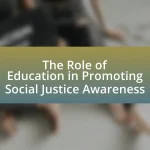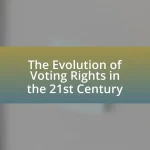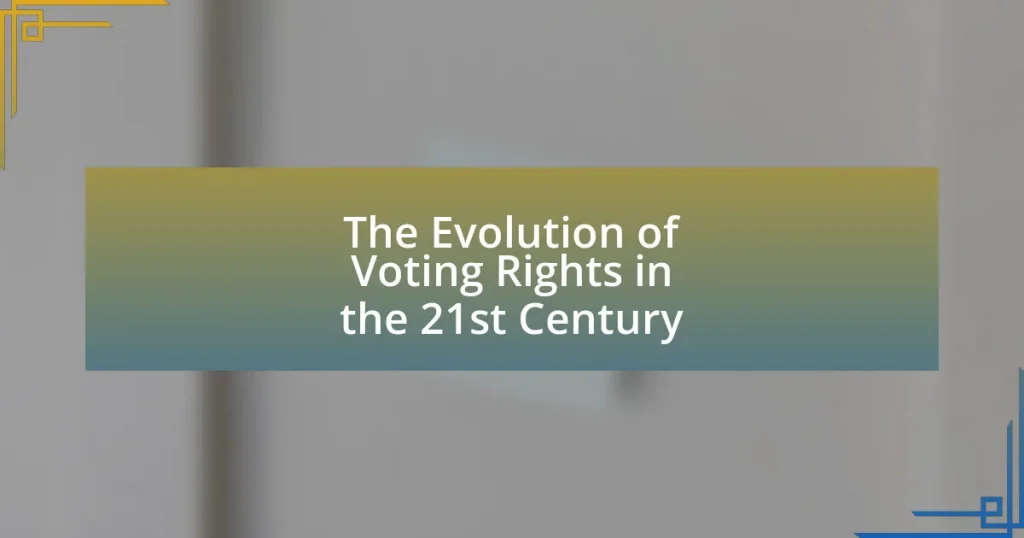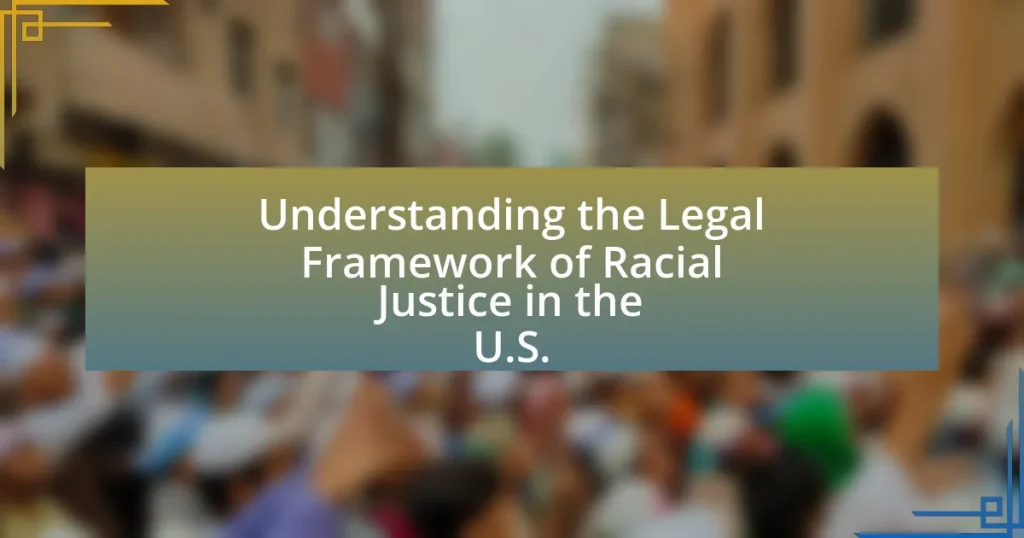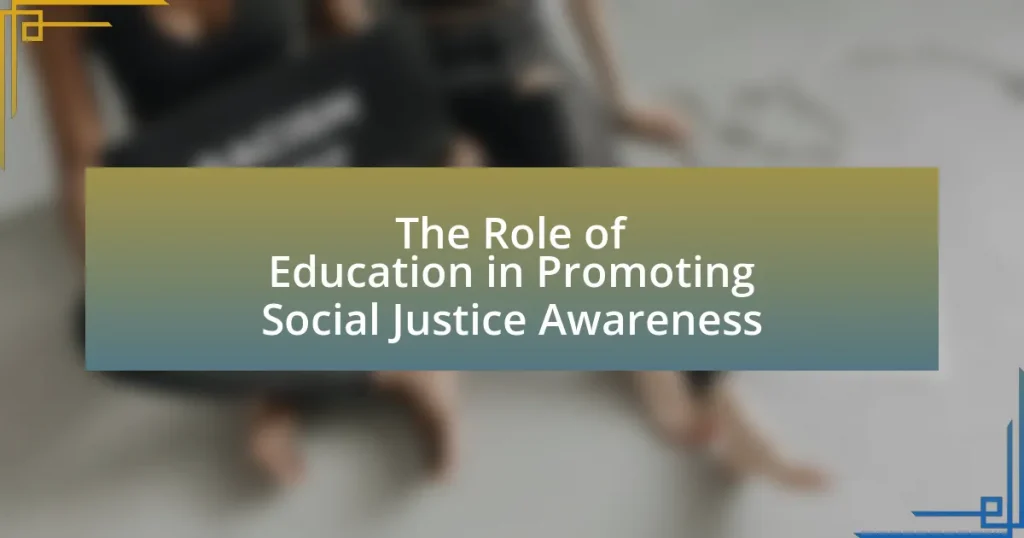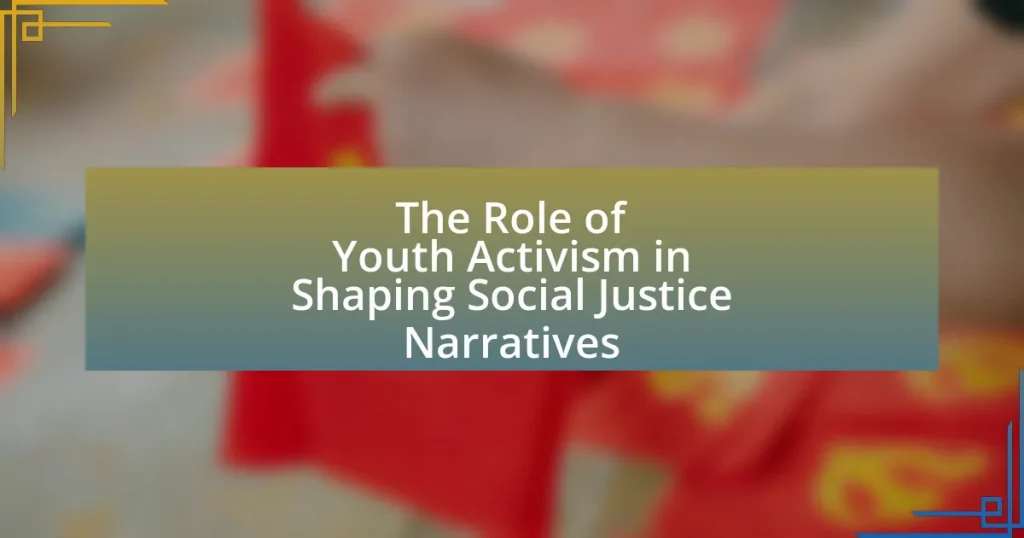The article examines the evolution of voting rights in the 21st century, highlighting key milestones such as the Help America Vote Act of 2002 and the Supreme Court’s Shelby County v. Holder decision in 2013, which impacted voting regulations. It discusses how historical events, landmark legislation, and social movements have shaped public perception and access to voting. The article also addresses the challenges of voter suppression tactics, the role of technology in mobilizing voters, and ongoing legal battles that influence voting rights. Additionally, it emphasizes the importance of grassroots organizations and community engagement in advocating for equitable voting access.
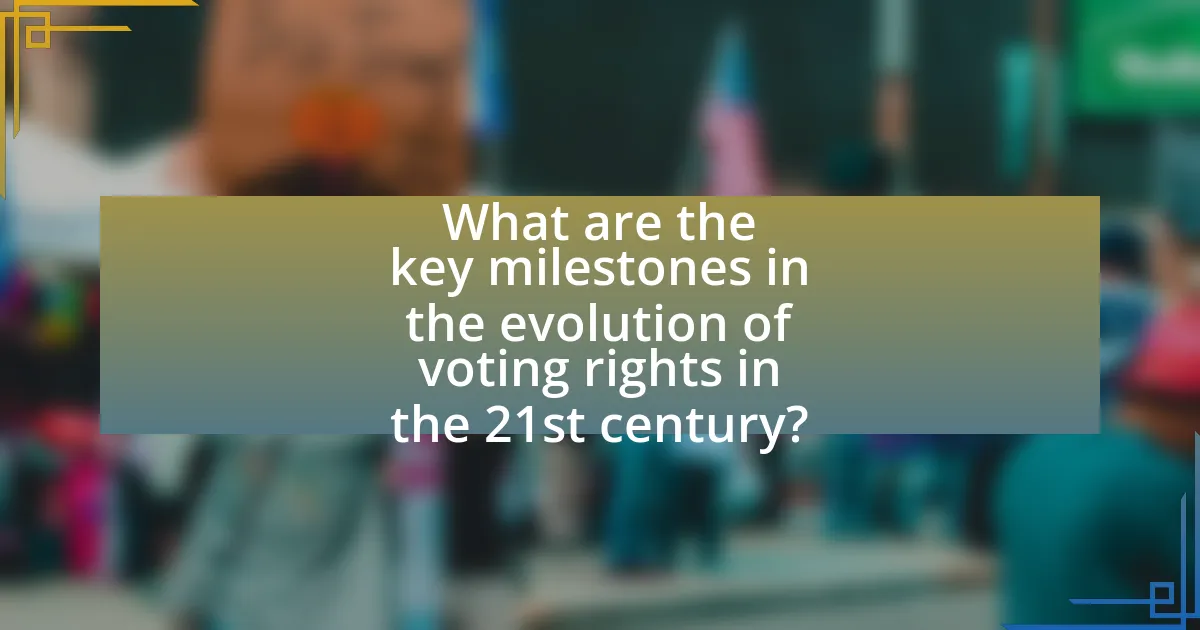
What are the key milestones in the evolution of voting rights in the 21st century?
Key milestones in the evolution of voting rights in the 21st century include the passage of the Help America Vote Act in 2002, which aimed to improve voting systems and accessibility following the 2000 presidential election controversies. In 2013, the Supreme Court’s decision in Shelby County v. Holder invalidated key provisions of the Voting Rights Act of 1965, significantly impacting states’ voting regulations. Additionally, various states have enacted measures to expand voting access, such as automatic voter registration and same-day registration, reflecting ongoing efforts to enhance voter participation. These events collectively illustrate significant changes and challenges in voting rights within the 21st century.
How have historical events shaped voting rights in this century?
Historical events have significantly shaped voting rights in this century by influencing legislation and public perception. For instance, the election of Barack Obama in 2008 highlighted racial and socioeconomic disparities in voting access, prompting discussions about voter ID laws and disenfranchisement. Additionally, the Supreme Court’s 2013 decision in Shelby County v. Holder weakened the Voting Rights Act of 1965, leading to a wave of state-level laws that restricted voting access, particularly affecting minority groups. These events have catalyzed movements advocating for expanded voting rights, such as the push for the John Lewis Voting Rights Advancement Act, which aims to restore protections against discriminatory voting practices.
What significant legislation has been enacted regarding voting rights?
The significant legislation enacted regarding voting rights includes the Voting Rights Act of 1965, which aimed to eliminate racial discrimination in voting, and the Help America Vote Act of 2002, which established new voting standards and improved access to the electoral process. Additionally, the John Lewis Voting Rights Advancement Act, introduced in 2021, seeks to restore and strengthen parts of the Voting Rights Act that were weakened by the Supreme Court in 2013. These laws collectively represent critical efforts to ensure fair and equitable voting access in the United States.
How have landmark court cases influenced voting rights?
Landmark court cases have significantly influenced voting rights by establishing legal precedents that protect and expand access to the electoral process. For instance, the Supreme Court’s decision in Brown v. Board of Education (1954) set a precedent against racial discrimination, which later influenced voting rights by challenging segregation in polling places. Additionally, the Voting Rights Act of 1965 was upheld in cases like Shelby County v. Holder (2013), which, while striking down certain provisions, highlighted the ongoing legal battles surrounding voter suppression and discrimination. These cases collectively underscore the judiciary’s role in shaping the legal landscape of voting rights, ensuring that access to the ballot remains a fundamental democratic principle.
What social movements have impacted voting rights in the 21st century?
Social movements that have significantly impacted voting rights in the 21st century include the Black Lives Matter movement, the Women’s March, and the fight for LGBTQ+ rights. The Black Lives Matter movement has highlighted systemic racism and voter suppression, advocating for policies that ensure equitable access to the ballot for marginalized communities. The Women’s March has focused on gender equality, including the push for policies that protect women’s voting rights and reproductive rights, emphasizing the importance of women’s participation in elections. Additionally, the LGBTQ+ rights movement has fought against discriminatory laws that affect voting access for LGBTQ+ individuals, advocating for inclusive policies that protect their rights. These movements have collectively influenced legislation and public awareness regarding voting rights, leading to reforms aimed at increasing voter access and participation.
How have grassroots organizations contributed to voting rights advocacy?
Grassroots organizations have significantly contributed to voting rights advocacy by mobilizing communities, raising awareness, and influencing policy changes. These organizations, such as the NAACP and the League of Women Voters, have engaged in voter registration drives, educational campaigns, and lobbying efforts to combat voter suppression tactics. For instance, the NAACP’s “Vote Your Voice” campaign has successfully registered millions of voters and highlighted issues like gerrymandering and voter ID laws that disproportionately affect marginalized communities. Their grassroots efforts have led to legislative changes, such as the expansion of early voting and the restoration of voting rights for felons in several states, demonstrating their critical role in shaping the voting landscape in the 21st century.
What role has technology played in mobilizing voters?
Technology has played a crucial role in mobilizing voters by enhancing communication, increasing access to information, and facilitating voter registration. Social media platforms, such as Facebook and Twitter, have enabled political campaigns to reach a broader audience, allowing for targeted messaging that resonates with specific demographics. For instance, during the 2020 U.S. presidential election, over 50% of voters reported that social media influenced their voting decisions, highlighting its impact on voter engagement. Additionally, online voter registration systems have simplified the process, leading to increased participation; states that implemented online registration saw a 10-20% rise in voter turnout. These advancements demonstrate that technology not only informs voters but also actively encourages them to participate in the electoral process.
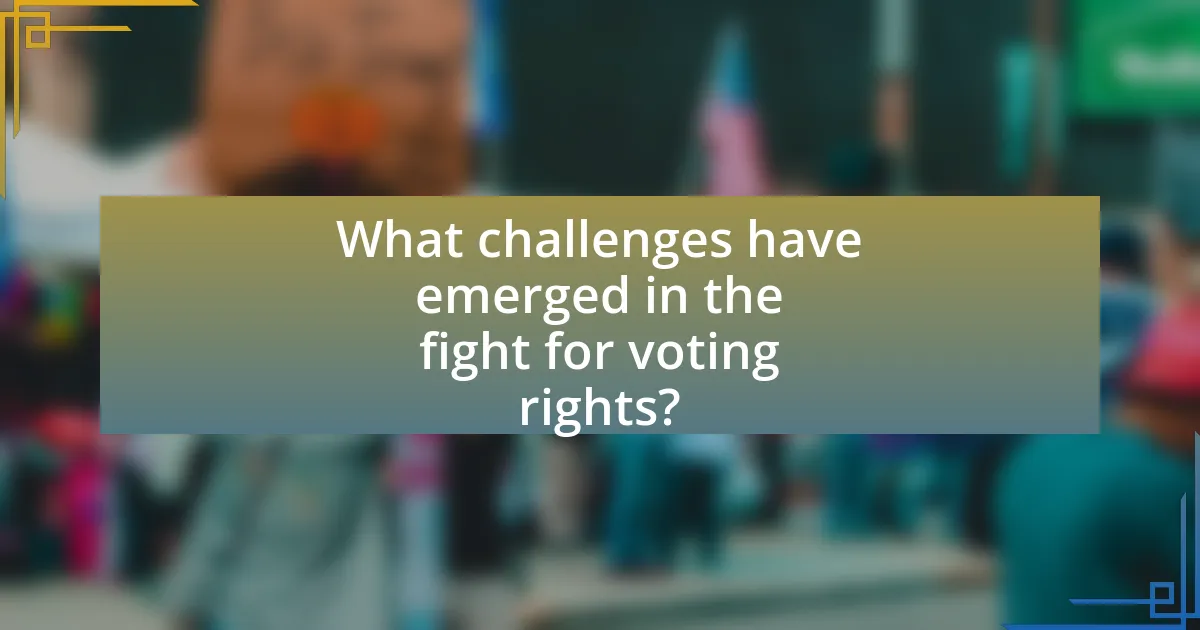
What challenges have emerged in the fight for voting rights?
Challenges in the fight for voting rights include voter suppression tactics, gerrymandering, and the impact of misinformation. Voter suppression tactics, such as strict ID laws and reduced polling places, disproportionately affect marginalized communities, leading to decreased voter turnout. Gerrymandering manipulates electoral district boundaries to favor one political party, undermining fair representation. Additionally, the spread of misinformation, particularly through social media, confuses voters about registration processes and voting procedures, further complicating access to the ballot. These challenges collectively hinder the progress made in ensuring equitable voting rights for all citizens.
How have voter suppression tactics evolved in recent years?
Voter suppression tactics have evolved in recent years through the implementation of stricter voter ID laws, purging of voter rolls, and limiting access to early voting and mail-in ballots. For instance, states like Georgia and Texas have enacted laws requiring specific forms of identification to vote, which disproportionately affect minority groups. Additionally, the U.S. Election Assistance Commission reported that over 17 million voters were purged from voter rolls between 2016 and 2018, often without adequate notice or justification. Furthermore, many states have reduced the number of polling places, leading to long lines and decreased access, particularly in urban areas. These tactics reflect a strategic shift towards more systemic barriers aimed at reducing voter turnout among specific demographics.
What are the most common forms of voter suppression today?
The most common forms of voter suppression today include strict voter ID laws, purging of voter rolls, limited access to polling places, and reduced voting hours. Strict voter ID laws require individuals to present specific forms of identification, which disproportionately affects minority and low-income voters who may lack such IDs. Purging of voter rolls often removes eligible voters, sometimes without proper notification, leading to confusion and disenfranchisement. Limited access to polling places, particularly in urban areas, results in long lines and increased difficulty for voters to cast their ballots. Additionally, reduced voting hours can make it challenging for working individuals to participate in elections. According to a report by the Brennan Center for Justice, these tactics have been shown to significantly lower voter turnout, particularly among marginalized communities.
How do these tactics disproportionately affect certain demographics?
Tactics such as voter ID laws, purging voter rolls, and limiting polling places disproportionately affect marginalized demographics, including racial minorities, low-income individuals, and the elderly. These groups often face greater barriers to obtaining identification, are more likely to be removed from voter rolls due to systemic issues, and may have less access to transportation or time to vote when polling locations are reduced. For instance, a study by the Brennan Center for Justice found that voter ID laws can reduce turnout among African American voters by up to 10%, highlighting the significant impact these tactics have on specific populations.
What legal battles are currently shaping the future of voting rights?
Current legal battles shaping the future of voting rights include cases addressing voter ID laws, gerrymandering, and access to mail-in voting. For instance, the Supreme Court’s consideration of cases like Brnovich v. Democratic National Committee has significant implications for the legality of certain voting restrictions, particularly in Arizona, which could influence similar laws nationwide. Additionally, ongoing litigation in states like Georgia and Texas challenges new laws perceived to suppress voter turnout, reflecting a broader national struggle over voting access and equity. These cases are pivotal as they may redefine the legal landscape surrounding voting rights in the United States.
Which states are at the forefront of voting rights litigation?
Georgia, Texas, and Florida are at the forefront of voting rights litigation. These states have been involved in numerous legal battles over voting laws, including voter ID requirements, voter roll purges, and access to polling places. For instance, Georgia’s controversial voting law enacted in 2021 led to multiple lawsuits claiming it disproportionately affects minority voters, while Texas has faced legal challenges over its restrictive voting measures passed in 2021. Florida’s voting laws have also been scrutinized, particularly regarding mail-in voting and ballot drop-off locations, prompting litigation aimed at protecting voter access.
What implications do these legal battles have for future elections?
Legal battles surrounding voting rights significantly impact future elections by shaping the legal framework governing electoral processes. These disputes often lead to changes in laws regarding voter ID requirements, mail-in voting, and redistricting, which can either enhance or restrict access to the ballot. For instance, the Supreme Court’s decision in Shelby County v. Holder (2013) invalidated key provisions of the Voting Rights Act, resulting in several states implementing stricter voting laws that disproportionately affect minority voters. Such legal precedents can create a ripple effect, influencing state legislatures to adopt similar measures, thereby altering the electoral landscape and potentially affecting voter turnout and representation in future elections.
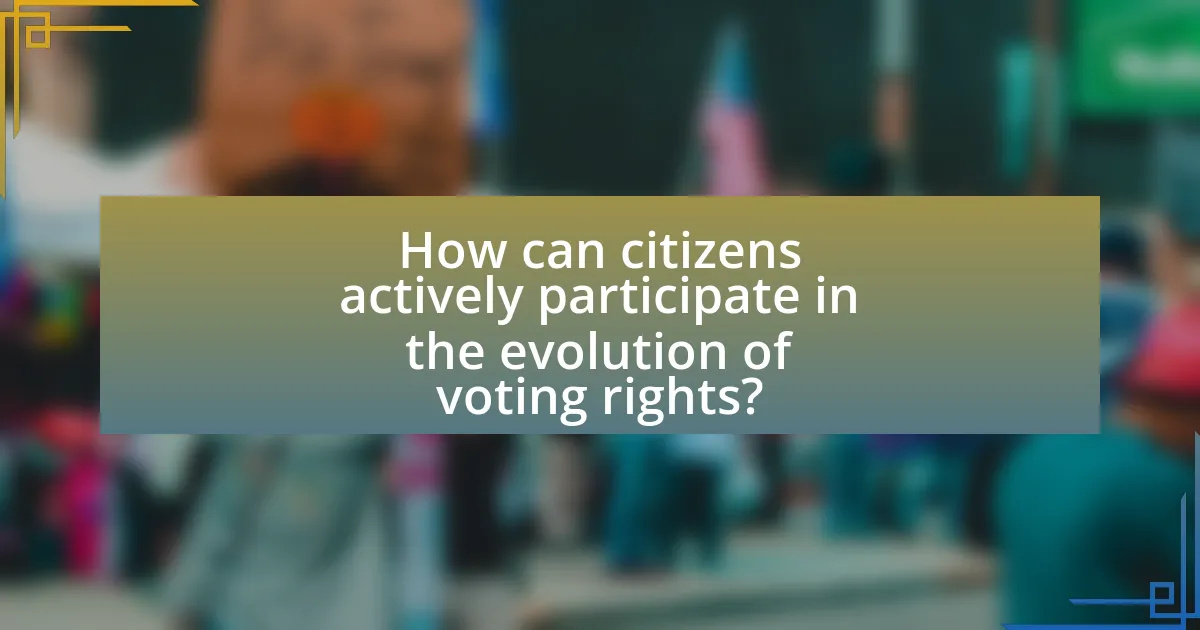
How can citizens actively participate in the evolution of voting rights?
Citizens can actively participate in the evolution of voting rights by engaging in advocacy, education, and grassroots organizing. Advocacy efforts can include lobbying elected officials to support legislation that expands voting access, such as automatic voter registration or the restoration of voting rights for felons. Education initiatives can involve informing fellow citizens about their voting rights and the importance of participation in elections, which can be supported by organizations like the League of Women Voters, which has a long history of promoting voter education. Grassroots organizing can mobilize communities to participate in local and national campaigns aimed at protecting and expanding voting rights, exemplified by movements like the Voting Rights Alliance, which seeks to unite various groups in the fight for equitable access to the ballot. These actions collectively contribute to shaping policies and public opinion regarding voting rights, demonstrating the power of citizen involvement in democratic processes.
What steps can individuals take to advocate for voting rights?
Individuals can advocate for voting rights by engaging in grassroots organizing, educating themselves and others about voting laws, and participating in advocacy campaigns. Grassroots organizing involves mobilizing community members to raise awareness about voting issues and to encourage voter registration. Education on voting laws, including understanding voter ID requirements and deadlines, empowers individuals to navigate the electoral process effectively. Participation in advocacy campaigns, such as those led by organizations like the American Civil Liberties Union, can amplify efforts to protect and expand voting rights. These actions are supported by data indicating that states with active grassroots movements have seen increased voter turnout and legislative changes favoring voting access.
How can community engagement enhance voter participation?
Community engagement enhances voter participation by fostering a sense of belonging and responsibility among citizens. When individuals are actively involved in their communities, they are more likely to understand the importance of voting and feel motivated to participate in elections. Research indicates that communities with strong engagement initiatives, such as local forums and outreach programs, see higher voter turnout rates. For example, a study by the Pew Research Center found that communities that organized voter registration drives and educational workshops experienced a 20% increase in voter participation compared to those that did not. This correlation demonstrates that active community involvement directly influences individuals’ likelihood to vote, thereby strengthening democratic processes.
What resources are available for educating others about voting rights?
Numerous resources are available for educating others about voting rights, including organizations, websites, and educational materials. Organizations such as the American Civil Liberties Union (ACLU) and the League of Women Voters provide comprehensive information on voting rights, including historical context, current legislation, and advocacy efforts. Websites like Vote.org and CanIVote.org offer tools for understanding voter registration, polling locations, and voting procedures. Additionally, educational materials such as books, documentaries, and online courses from platforms like Coursera and edX focus on the evolution of voting rights and civic engagement. These resources collectively support informed discussions and actions regarding voting rights in the 21st century.
What best practices should citizens follow to ensure their voting rights are protected?
Citizens should register to vote and verify their registration status regularly to ensure their voting rights are protected. Maintaining an updated voter registration helps prevent issues on election day, as evidenced by the U.S. Election Assistance Commission, which reported that 1 in 4 eligible voters are not registered. Additionally, citizens should educate themselves about their voting rights and local election laws, as understanding these can help them identify and challenge any potential violations. Engaging with local advocacy groups can also provide resources and support for protecting voting rights, as organizations like the American Civil Liberties Union actively work to safeguard these rights through legal action and public awareness campaigns.
How can individuals stay informed about changes in voting laws?
Individuals can stay informed about changes in voting laws by regularly checking official state election office websites and subscribing to updates from reputable organizations focused on voting rights. State election offices provide the most accurate and timely information regarding any modifications to voting laws, including registration requirements and voting procedures. Organizations such as the National Association of Secretaries of State and the Brennan Center for Justice also offer resources and updates on legislative changes, ensuring individuals have access to reliable information.
What actions can be taken to report and combat voter suppression?
To report and combat voter suppression, individuals can document incidents, contact local election officials, and engage with advocacy organizations. Documenting incidents involves collecting evidence such as photographs, videos, or written accounts of suppression tactics, which can be reported to election officials for investigation. Contacting local election officials ensures that complaints are formally registered and addressed, as they are responsible for maintaining fair election practices. Engaging with advocacy organizations, such as the NAACP or the ACLU, provides additional resources and support for addressing systemic issues related to voter suppression. These organizations often have established channels for reporting suppression and can mobilize community efforts to combat it effectively.

